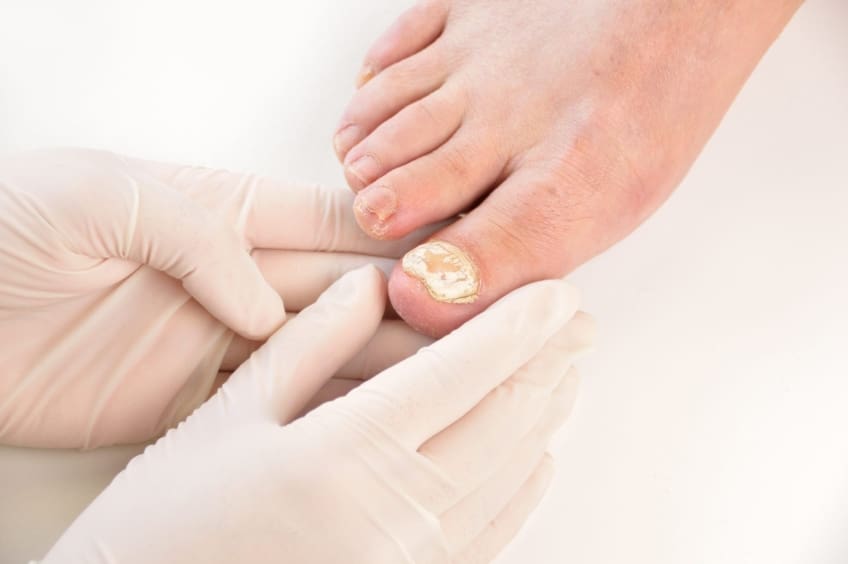
What is a nail fungal infection?
A nail infection is caused by a fungus. This infection can happen in toenails and fingernails. It is more common in toenails. A fungal infection of the nail is also called onychomycosis.
Symptoms of a nail fungal infection
Symptoms affect the nail and can include nails that are:
- Discolored (usually white or yellow)
- Brittle
- Crumbly, or have rough, jagged edges
- Thick
- Separated from the nail bed
- Curled up or down, or are distorted in shape
The infection can cause pain if it is severe. Some people with fungal nail infections have athlete’s foot. This is a similar condition that affects the skin around the toes.
Fungal infections can also lead to ingrown toenails as well.
What causes a nail fungal infection?
The infection is usually caused by exposure to a fungus. The fungus grows in wet, dark conditions. The fungus grows when your feet are in warm, sweaty environment (socks, work boots). It enters your nail through a crack in the nail.
Nail fungal infections happen at any age. They are more common in adults older than 60 years of age. They are common in people who have diabetes or circulation problems. They also are common in people with a weakened immune system. Men are more likely than women to get fungal nail infections.
How is nail fungal infection diagnosed?
Your doctor will look at your nails and ask you questions. They might clip a sample of your nail and send the sample to a lab to see if you have an infection. There could be other causes for your symptoms and your doctor can help reveal what those are.
Can a nail fungal infection be prevented or avoided?
Avoid situations that expose you to a fungus. This includes walking barefoot in locker rooms and having wet hands and feet often. This might be a problem for people who work in restaurants or house cleaning. People in a family can get nail fungal infections at the same time. This happens when their immune systems aren’t able to fight off the infection. Or it could be the infection is spread when using the same towels. It is important to routinely clean your shower, tub, and bathroom to lower risk of fungal infection.
Nail fungal infection treatment
Prescription medicines can treat a fungal nail infection. Oral antifungal medicines help a new nail grow. This will replace the infected nail. You may need to take antifungal medicine for 6 to 12 weeks. Some oral medicines are not safe for people who have liver problems. They are not safe for people who have a history of congestive heart failure. Tell your doctor if you have one of these conditions. Your doctor will decide which medicine is right for you.
Apply topical treatments (creams and polishes) to the top of your nail. Topical medicines usually do not cure fungal nail infections.
In severe cases, a doctor might remove the nail completely. It can take several months to a year for the infection to go away.
Living with a nail fungal infection
If you have a nail fungal infection, some things can help:
- Keep your nails cut short and file down any thick areas.
- Don’t use the same nail trimmer and file on healthy nails and infected nails. If you have your nails professionally manicured, bring your own nail file and trimmer from home.
- Wear waterproof gloves for wet work (such as washing dishes or floors). Wear 100% cotton gloves for dry work.
- Wear socks made of wicking material (high-tech polyester). This pulls moisture away from the skin. Change your socks when they are damp from sweat or if your feet get wet. Put on clean, dry socks every day. Put over-the-counter antifungal foot powder inside your socks to keep your feet dry.
- Wear shoes with good support and a wide toe area. Don’t wear pointed shoes that press your toes together.
- Avoid walking barefoot in public areas, such as locker rooms.
Questions to ask your doctor
- Are treatments usually effective?
- Are there any side effects of the treatment?
- If my treatment works, will my nail grow back normally?
- If I’ve had one fungal nail infection, am I likely to get another?
- What kinds of shoes should I wear?
![]()
Copyright © American Academy of Family Physicians
This information provides a general overview and may not apply to everyone. Talk to your family doctor to find out if this information applies to you and to get more information on this subject.









